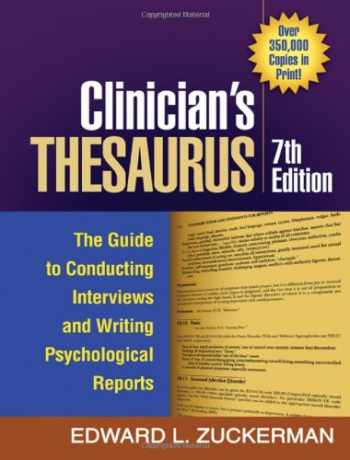Out of stock
Test bank for Clinicians Thesaurus 7th Edition by Edward L. Zuckerman
Digital item No Waiting Time Instant DownloadBy: Edward L. ZuckermanISBN-10: 1606238744ISBN-13: 9781606238745Language: EnglishAuthors: Edward L. ZuckermanPublisher: The Guilford Press
Original price was: $55.00.$50.00Current price is: $50.00.
Test bank for Clinicians Thesaurus 7th Edition by Edward L. Zuckerman
Table Of ContentsAcknowledgments and an Invitation xviiGetting Oriented to theClinician’s Thesaurus1What Is theClinician’s Thesaurusand What Does It Do?, 1How This Book Is Organized, 2Understanding the Style and Format of the Chapters, 3 A Functional Guide to Report Construction, 7 Further Guidelines and Advice on Report Writing, 13Some Ways to Use theClinician’s Thesaurus, 16 A Cautionary Note and Disclaimer, 17PART I. Conducting a Mental Health Evaluation1. Beginning and Ending the Interview 211.1. Structuring the Interview, 21 1.2. Introducing Yourself and Noting Possible Communication Difficulties, 21 1.3. Assessing the Client’s Understanding of the Interview Situation, 22 1.4. Obtaining Informed Consent, 23 1.5. Other Points for All Interviews, 23 1.6. Eliciting the Chief Concern/Complaint/Issue, 24 1.7. Eliciting the Client’s Understanding of the Problem, 24 1.8. Dimensionalizing the Concern/Problem, 24 1.9. Ending the Interview, 252. Mental Status Evaluation Questions/Tasks 262.1. Introduction to the Mental Status Questions, 26 2.2. Background Information Related to Mental Status, 27 2.3. Rancho Los Amigos Cognitive Scale, 27 2.4. Glasgow Coma Scale, 28 2.5. Orientation, 28 2.6. Attention,302.7. Concentration,302.8. Comprehension of Language, 31 2.9. Eye–Hand Coordination/Perceptual–Motor Integration/ Dyspraxia/ Constructional Ability, 312.10. Memory, 322.11. Fund of Information, 342.12. Opposites, 352.13. Differences, 362.14. Similarities/Analogies, 362.15. Absurdities, 362.16. Calculation Abilities, 37 2.17. Abstract Reasoning/Proverbs, 38viiiContents2.18. Paired Proverbs, 382.19. Practical Reasoning, 392.20. Social Judgment, 392.21. Decision Making, 402.22. Self-Image, 402.23. Insight into Disorder, 402.24. Strengths and Coping, 412.25. Mental Status Evaluation Checklist, 413. Questions about Signs, Symptoms, and Other Behavior Patterns 443.1. Introduction to the Questions about Signs, Symptoms, andBehavior Patterns, 44 3.2. Abuse (Nonsexual)/Neglect of Spouse/Elder, 45 3.3. Abuse (Nonsexual)/Neglect of Child, 46 3.4. Abuse (Sexual) of Child or Adult, 46 3.5. Affect/Mood, 47 3.6. Anxiety, 48 3.7. Body Dysmorphic Disorder, 48 3.8. Compliance–Noncompliance with Treatment, 48 3.9. Compulsions, 493.10. Delusions, 503.11. Depression, 513.12. Dissociative Experiences, 533.13. Eating Disorders, 543.14. Gay and Lesbian Identity Formation, 563.15. Hallucinations, 563.16. Illusions, 583.17. Impulse Control, 583.18. Mania, 583.19. Obsessions, 593.20. Organicity/Cognitive Disorders, 603.21. Pain, Chronic, 603.22. Paranoia, 613.23. Phobias, 623.24. Self-Injury, 623.25. Sexual History, 633.26. Sexual Identity/Transgender Issues, 653.27. Sleep, 663.28. Substance Abuse: Drugs and Alcohol, 67 3.29. Substance Use: Tobacco and Caffeine, 753.30. Suicide and Self-Destructive Behavior, 763.31. Violence, 78PART II. Standard Terms and Statements for WordingPsychological ReportsA. Introducing the Report4. Beginning the Report: Preliminary Information 834.1. Heading and Dates for the Report, 834.2. Sources of Information for the Report, 834.3. Identifying Information about the Client, 844.4. Self-Sufficiency in Appearing for Examination, 854.5. Consent Statements, 864.6. Reliability/Validity Statements, 87 4.7. Confidentiality Notices, 894.8. Ethical Considerations in Report Writing, 91Contentsix5. Referral Reasons 925.1. Statement of Referral Reason, 925.2. Common Referral Reasons for Children at Home, 935.3. Common Referral Reasons for Children at School, 935.4. Common Referral Reasons for Children at Both Home and School, 956. Background Information and History 976.1. History/Course of the Present/Chief Complaint/Concern/Problem/Illness, 97 6.2. Medical History and Other Findings, 986.3. Personal, Family, and Social Histories, and Current Social Situation, 996.4. Adjustment History, 1026.5. Social History for a Disability Examination, 1036.6. Family Genogram/Family Tree/Pedigree, 104B. The Person in the Evaluation7. Behavioral Observations 1077.1. Appearance, 107 7.2. Clothing/Attire, 110 7.3. Movement/Activity, 111 7.4. Speech Behavior, 114 7.5. Other Behavioral Observations, 1178. Responses to Aspects of the Examination 1188.1. Reaction to the Context of the Evaluation, 118 8.2. Attention/Concentration/Effort, 120 8.3. Response to the Methods of Evaluation/Tests/Questions, 121 8.4. Persistence/Motivation, 122 8.5. Relationship with the Examiner, 123 8.6. Response to Success/Failure/Feedback, 1259. Presentation of Self 1279.1. Dependency–Surgency, 127 9.2. Presence/Style,1279.3. Self-Image/Self-Esteem, 128 9.4. Social Sophistication/Manners, 128 9.5. Warmth–Coldness, 129 9.6. Other Aspects of Self-Presentation, 12910. Emotional/Affective Symptoms and Disorders 13210.1. General Aspects of Mood and Affects, 13210.2. Anger, 13310.3. Anxiety/Fear, 13410.4. Bipolar I Disorder, 13610.5. Bipolar II Disorder, 13610.6. Cyclothymia, 137 10.7. Depression, 137 10.8. Guilt/Shame, 14210.9. Mania, 14310.10. Panic, 14410.11. Seasonal Affective Disorder, 14410.12. Sexuality, 14510.13. Other Affects/Emotional Reactions, 145xContents

Reviews
There are no reviews yet.